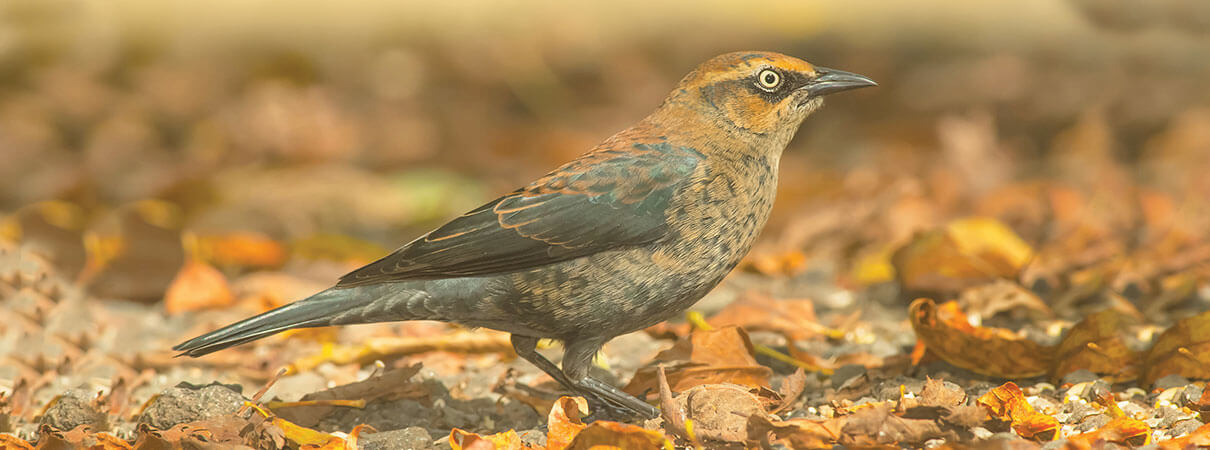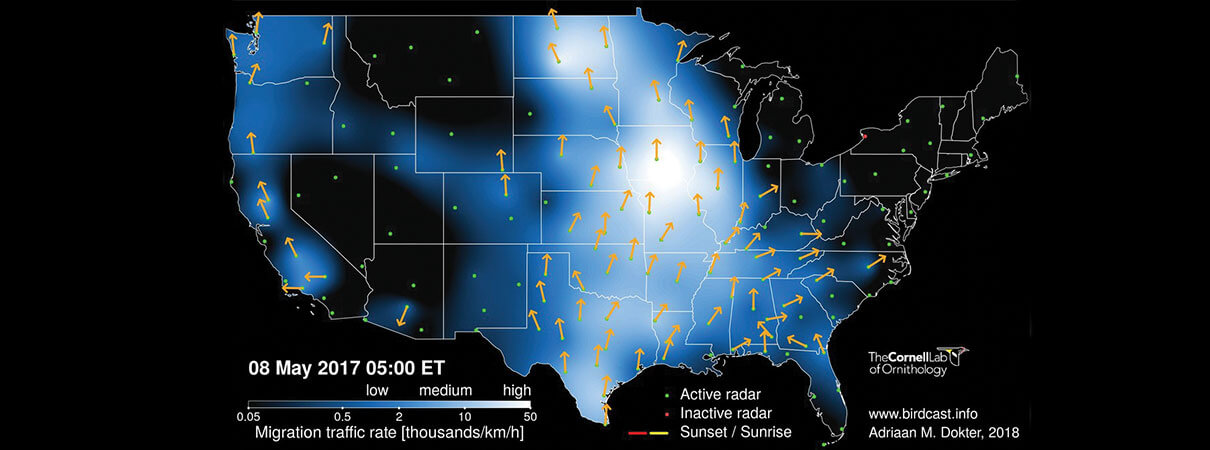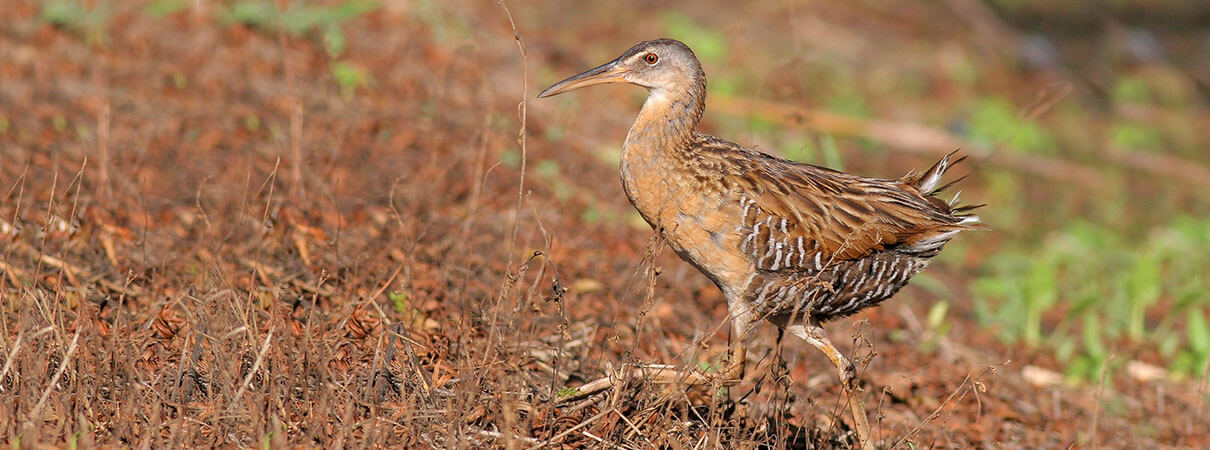Within a Lifetime: 3 Billion Birds Lost
Dr. Donald Messersmith remembers June 1970 for laborious but enjoyable hours spent in the rolling fields around Pleasant Valley, Maryland. A life-long birder and University of Maryland emeritus professor, Messersmith recalls volunteering with some of his students, running a route for the North American Breeding Bird Survey (BBS), then a fledgling bird monitoring effort. Their goal: to tally as many singing and nesting birds as possible.
“We would get started about 5:30 in the morning listening for birds, would do our route very carefully, and at every half-mile stop we had a lot of birds,” remembers Messersmith. “Bobwhites were common; we would hear them all the time. Meadowlarks were regular. There were Grasshopper Sparrows and Vesper Sparrows. In other words, the grassland birds, which are now in trouble, were not in trouble in those days.”
Fast-forward 50 years. “There aren't as many birds now,” reflects Messersmith, who still leads bird walks in his community. He hasn't seen a bobwhite in five years: They're disappearing from the region, along with other species, declines chronicled by the volunteer-fueled BBS, which continues to this day under the auspices of the U.S. Geological Survey and Canadian Wildlife Service.

Western Meadowlark. Photo by Paul Tessier/Shutterstock
Through the decades since 1970, much has changed relating to social issues, politics, style, and technology. Striking physical change has come as well: In 1970, the United States population was 205 million people. It's since grown by more than half, to 330 million. Canada's population also jumped by more than half, from 21 to 35 million. This growth has affected the landscape, as demands for various resources have grown. In many places, forest, meadow, desert scrub, and small family farms have been replaced by expansive industrialized farms and warehouses, and spidery suburban clusters strung across the countryside on wide webs of pavement.
Recent studies sounded alarms on declines in large mammals, amphibians, and insects, and on the impacts of climate change on wildlife. Now a new study sheds light on five decades of loss in the most easily observed animal class. “Decline of the North American Avifauna,” published in Science in September, reveals that since 1970, the combined avian population of the United States and Canada shriveled by a net of more than a quarter, or almost 3 billion birds.
Five decades, within a human lifetime, is a blip in geologic time, not much time at all to see so much change. Looking back at decades of data, including the tallies of Messersmith and thousands of other citizen-science birders, the authors found startling declines even among some of the most abundant bird species.
Birds' colors, varied behaviors, and songs inspire and delight. But the loss of this much bird biomass goes beyond impacting our enjoyment. These feathered insect-eaters, scavengers, predators and prey, pollinators, and avian “johnny appleseeds” are crucial to the health of food webs and ecosystems. The study reminds us that we need to watch, study, and most of all act — because humanity has everything to do with the well-being and future of our birds, and our world.

Red Knots. Photo by Martin Pelanek/Shutterstock
Ken Rosenberg, a senior scientist at ABC and the Cornell Lab of Ornithology, is the paper's lead author. He says, “This is the first analysis to look at the net change in total population, across North American bird species, and we see this staggering net loss in breeding birds, across all habitats, and including generalists.” Twelve bird families accounted for 90 percent of the cumulative loss, including sparrows, warblers, blackbirds, and finches.
The study's 11 co-authors represent a range of nonprofit and public organizations: ABC, Bird Conservancy of the Rockies, Cornell Lab of Ornithology, Environment and Climate Change Canada, Georgetown University, the Smithsonian Institution's Migratory Bird Center, and the U.S. Geological Survey.
The study puts a microscope on population changes for 529 species, or 76 percent of the species breeding in the United States and Canada. The authors analyzed longstanding, “on-the-ground” survey work and population estimates, but also put eyes to the skies, using computers to crunch spring data via weather radar. The authors consider their estimates conservative because they only take into account birds returning to breed (in the case of the radar) and those breeding (in counts). “The question we had,” says Rosenberg, “is if you account for decreasing and increasing species, is there a shift toward more common/generalist species? We found that this was not the case.” Instead, there seemed to be a large net decline. “We decided this was big news,” he says.
Apocalypse No, Troubling Yes
When it came to covering the study, the media dove in and made a big splash: CNN, Fox News, major TV networks, dozens of radio stations, The New York Times, The Washington Post, The Wall Street Journal, BBC News, CBC News, and so on. While increasing people's awareness is important, Rosenberg worries that many stories written about the study miss an important point, highlighting instead nightmare scenarios.

Rusty Blackbird. Photo by Paul Reeves Photography, Shutterstock
“We're seeing troubling loss. But we are not at the point of an apocalypse. The skies are not emptying,” says Rosenberg. “What we're saying is that this loss of abundance is big and real and we need to pay attention before it is too late. What's new and different here is this erosion of abundance among the common birds. If we weren't doing these detailed year-to-year surveys, we wouldn't know about it.”
The paper gives the extinct Passenger Pigeon a cameo mention, as a cautionary poster bird. Once the continent's most abundant bird species, by 1900, the blue-gray and orangish dove bowed to widespread deforestation and over-hunting, vanishing from the wild. Fourteen years later, the last individual died in a zoo. Today, the species inhabits only the collective memory, its plumage only seen on taxidermy specimens found in some museum exhibits and drawers.
“The decline of the Passenger Pigeon looked a lot like what we're seeing in the common birds today,” says Rosenberg. “No one thought that the Passenger Pigeon would go extinct. If we could have monitored them, we almost certainly could have prevented that extinction.”

Northern Bobwhites. Photo by Jacob Spendelow
Grassland birds are a group that Rosenberg most fears could go the way of the Passenger Pigeon. According to the study's data, since 1970, grassland birds have been the most hard-hit group, losing more than 700 million breeding individuals across 31 species. In all, 74 percent of grassland species were in decline, and this group sustained the largest proportional loss, at 53 percent. In recent decades, similar losses have been logged in farmlands across Europe and in other parts of the world.
“We lost 90 percent of native grasslands,” says Rosenberg. “The birds that are left are squeezed in around the agriculture. And there's been an intensification of agriculture and greater use of more-toxic pesticides. When we eliminate the last bits of habitat and the insect food supply, then our landscapes can't support birds or other wildlife.”
Tracking Birds Like Weather
A backbone of the study's data comes from bird count surveys including the BBS, which started in 1966. But to shed a different light on declines, the study's authors looked beyond the visual abilities of mere mortals, tapping data gathered nonstop by 143 NEXRAD weather radars. Coauthor Adriaan Dokter, a research associate at the Cornell Lab of Ornithology, moved from Europe to the United States in good part to work with the colossal bird data set provided by these radars. “We had this focus on counting how much was lost in absolute terms and we wanted two independent ways of looking at it. It's been only a few years that analyzing vast amounts of radar data has been technologically feasible, and it comes together at just the right moment for us to look both in the skies and of course on the ground with the counts.”
One criticism of bird counts is that it's impossible to tally all birds. Many boreal forest birds and shorebirds, for example, nest in wilderness areas with few roads and people. “Radar, as an independent source of information, really helps us,” says Dokter. Although weather radar cannot allow ornithologists to identify which species and how many individuals are flying, they provide an all-seeing eye on the skies that observers can't match. “The radar network counts all the birds passing over in a year above our heads at night, in each region of the U.S. — many more individuals than we could ever count on the ground,” says Dokter. “And we find the same result: a dramatic net decrease in the amount of living birds that fly by.”

This map, generated using NEXRAD satellite data, shows the "bird biomass" in flight at 5 a.m. on a May morning. Image courtesy of The Cornell Lab of Ornithology
How do meteorologists and biologists know the difference between clouds and living things? Birds move faster, for one thing. And masses of birds show up when weather is otherwise clear. As far back as World War II, people noticed “angels,” mysterious images in radar that we now know were migrating birds. Over the years, some pioneering scientists started using radar technology to study birds' flight behavior.
Now things are much more clear. Today's large networks of weather radars, combined with super computers' boosted analysis capabilities, allow a far more comprehensive view. “The huge data centers of internet companies can handle enormous data sets,” says Dokter. “Every five or ten minutes the radars spit out more new data, continuously expanding the historical archive of weather data. We're able to look at the entire air space of the United States, and it's always on.”
Scientists now also use algorithms to teach computers to recognize the differing signatures of not just rain and other precipitation, but also moving masses of birds and insects. A recent upgrade of the radar network has greatly enhanced researchers' ability to distinguish between living birds and daily weather.
In the Science study, radar data helped to prove that habitat generalist species weren't filling the void as scarcer species declined. “Mostly common birds are measured in the radar bird biomass,” says Dokter, “and what we found using the radar was this general loss of birdlife.” Looking at spring night-time radar data from 2007 to 2017, the study reports a 14-percent decline in migration biomass. The investigators chose to only analyze spring migration data because this passage happens the closest to breeding season and also during a time when there are fewer insect flights to cause confusion.

King Rail. Photo by Greg Lavaty
Going for the Rebound
The paper does not quantify or delineate causes, but the authors suggest “multiple and interacting threats” are at play. Habitat loss is likely the largest driver, plus the widespread effects — both directly and indirectly (through food sources) — of pesticide use. The researchers hint at what might happen if nothing is done to turn the tide: “Today, monitoring data suggest that avian declines will likely continue without targeted conservation action, triggering additional endangered species listings at tremendous financial and social cost,” not to mention their invaluable worth in natural goods and services.
While skeptics might think birds can't face a bright future in our increasingly crowded world, the study's authors write: “History shows that conservation action and legislation works,” adding that “societal change” will also be required to prioritize and incorporate the needs of other living things and ecosystems. When these forces came into play for raptors and waterfowl, they rebounded.
When lead author Ken Rosenberg thinks back to 1970 and before, his most vivid memories recall the rarest birds, species now back from the brink. “I remember my father and I drove to the far east end of Long Island to see the only remaining Osprey pair,” he recalls. “And seeing a Bald Eagle in those days was really a big deal.” Today, Long Island alone hosts 300 nesting Osprey pairs, and the species has recovered in many other parts of its range, following better protection, improved water quality under the Clean Water Act, and the ban on DDT. And New York now has a growing Bald Eagle population of more than 400 nesting pairs. The study found that as a group, raptors increased by 200 percent, and that waterfowl were up more than 50 percent. Just as there was a sea change in efforts to save these charismatic birds, the recently released landmark study lays out a new challenge: for us to rescue the rest, for their sake and ours.
 | Howard Youth is ABC's Senior Writer/Editor, and is the author of Field Guide to the Natural World of Washington, D.C. |


















































